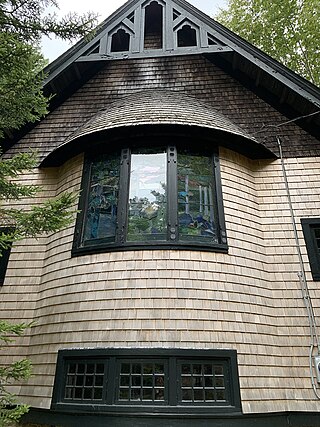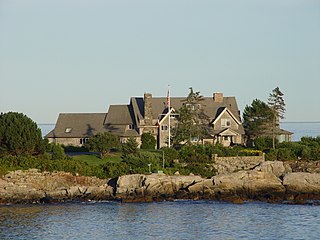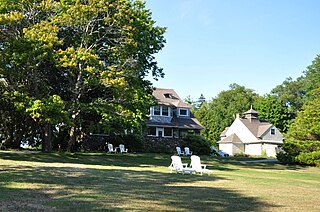
The Spite House, also known as the Thomas McCobb House, is a historic house at Deadman's Point in Rockport, Maine. Built in 1806 in Phippsburg, it is a high quality example of Federal period architecture. It was built by Thomas McCobb as a deliberately elaborate building to exceed in quality the fine house in which he had grown up, which he had lost in a family dispute. It was moved to its current location in 1925, and was listed on the National Register of Historic Places in 1974.

The East Main Street Historic District is a small residential historic district in Waltham, Massachusetts. It encompasses part of an area that was, before the 1813 construction of the Boston Manufacturing Company further west, developing as a center of the community. Because of the company's economic influence, the center was more fully developed further west, and East Main Street became a fashionable area for upper class housing. The four houses on the south side of East Main Street between Townsend Street and Chamberlain Terrace are a well-preserved remnant of this later period. The district was listed on the National Register of Historic Places in 1989.

The Hyde Avenue Historic District is a residential historic district encompassing the stylistic range of houses being built in the Newton Corner area of Newton, Massachusetts in the 1880s. It includes the five houses at 36, 42, 52, 59, and 62 Hyde Avenue, The district was added to the National Register of Historic Places in 1986.

The Vanderbilt Lane Historic District is a small area along the street of the same name, just east of US 9 in Hyde Park, New York, United States. It was used for the farm functions of the nearby estate of Walter Langdon and, later, Frederick Vanderbilt. Most of its buildings date to the turn of the 19th century, with one remaining from the 1830s.

Saint Jude's Episcopal Church is a historic church at 277 Peabody Drive in Seal Harbor, Maine. Built in 1887–89, this Shingle-style church is the least-altered surviving example of ecclesiastical architecture in Maine designed by the noted exponent of the style, William Ralph Emerson. Principally used as a summer chapel, it is affiliated with the Episcopal mission of St. Mary's in Northeast Harbor. The building was listed on the National Register of Historic Places in 1986.
The Union Church of Vinalhaven is a historic church on East Main Street in the center of Vinalhaven, Maine. Built in 1899, it is a high quality example of Shingle style architecture, designed by one of its major promoters, John Calvin Stevens. It was listed on the National Register of Historic Places in 1984.

The Kennebunk River Club is a private recreational and social club at 116 Ocean Avenue in Kennebunkport, Maine. Established in 1888 by summer residents of the resort area, its main building, constructed the following year, is a high-quality example of Shingle style architecture, and was listed on the National Register of Historic Places in 1975.

The John Calvin Stevens House is an historic house at 52 Bowdoin Street in the West End neighborhood of Portland, Maine. Built in 1884, it was the home of architect John Calvin Stevens, and was one of Portland's earliest examples of Shingle style architecture. The house was prominently used by Stevens in promotion of the style, and was listed on the National Register of Historic Places in 1973.

The Wood House is a historic house at the southeast corner of New Hampshire Routes 101 and 137 in Dublin, New Hampshire. Built in 1890, it is a locally distinctive example of Shingle style architecture with Romanesque features. The house was listed on the National Register of Historic Places in 1983.
Redwood is a historic summer house at 10 Barberry Lane in Bar Harbor, Maine. Designed by William Ralph Emerson and built in 1879, it was the first Shingle style house built in Bar Harbor, and is one of the oldest of the style in the nation. The house was listed on the National Register of Historic Places in 1978.

The Cape Arundel Summer Colony Historic District encompasses an enclave of large summer estates on the coast of Kennebunkport, Maine. The area was developed in the late 19th and early 20th century as a resort area for the wealthy of the northeastern United States. It notably includes the Kennebunk River Club and Walkers Point, the location of the Bush compound, which has a Shingle-style house built in 1903. The district was listed on the National Register of Historic Places in 1984.

Pebbledene is a historic house at 99 Freeman Street in the York Beach area of York, Maine. Built in 1896, this Queen Anne/Shingle style house was the last large-scale summer house built in the area. It was listed on the National Register of Historic Places in 1993.

The Auburn–Harpswell Association Historic District encompasses a well-preserved enclave of summer residences built in the early 20th century in southern Harpswell, Maine. The district includes ten Shingle style houses, a Colonial Revival dining hall, and a Greek Revival meeting hall. The Auburn Colony, an exclusive company of businessmen from Auburn, Maine, was responsible for their development. The district was listed on the National Register of Historic Places in 1985.

Cold Spring Farm is a historic house on Cold Spring Farm Road in Phippsburg, Maine. Built in 1774 by a Loyalist refugee from Boston, it is a fine and well-preserved example of Georgian architecture in brick. It was listed on the National Register of Historic Places in 1985.

The Charles H. Ingraham House is a historic house at 907 Popham Road in Phippsburg, Maine. Built in 1897, it is one of the finest Shingle style houses in Phippsburg, and is Maine's only known design by Providence, Rhode Island architect Howard K. Hilton. The house is now known as Stonehouse Manor, a bed and breakfast inn.

The Joseph and Susan Manley Summer Cottage is a historic house on Club Road in the Small Point area of Phippsburg, Maine. Built in 1887, it is one of the largest and most elaborate summer houses in the community, and is a fine Queen Anne structure designed by a prominent Maine architect. It was built for Joseph Homan Manley, a prominent Maine political operative, and was listed on the National Register of Historic Places in 1998.

The Percy District School House is a former district school at the junction of Parker Head and Cox Head Roads in Phippsburg, Maine. Now adapted for use as a private residence, this 1830s school house is one of a small number of 19th-century district schools in the state to be built out of granite blocks. It was listed on the National Register of Historic Places in 1999.

The Small Point Club is a historic private social club at 64 Club Road in the Small Point area of Phippsburg, Maine. Built in 1896 as part of a summer development started by Joseph Homan Manley, it is a fine local example of Victorian Stick and Shingle style architecture, designed by Maine native Joseph L. Neal. It was listed on the National Register of Historic Places in 1999.

Pendle Hill is a historic summer house between United States Route 202 and China Lake in South China, Maine. Built in 1916, it served as the summer home of Quaker theologian, historian, and writer Rufus Jones until his death in 1948. The property was listed on the National Register of Historic Places in 1983.

The Moses Webster House is a historic house at 14 Atlantic Avenue in Vinalhaven, Maine. It was built in 1873 for Moses Webster, owner of one of Vinalhaven's granite quarries, and is one of the community's finest examples of Second Empire architecture. It was listed on the National Register of Historic Places in 1998.




















